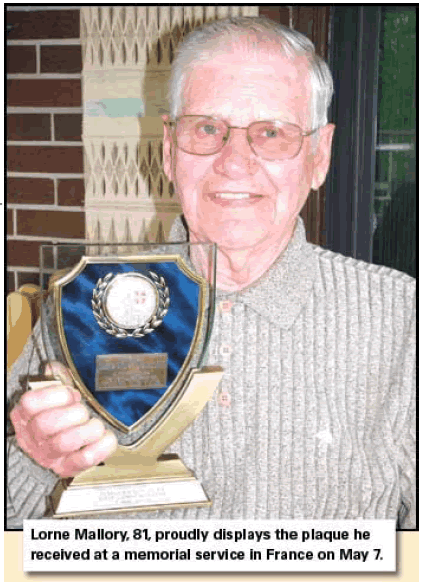Local vet remembers lost comrades
By Heather McCrae
The Scugog Standard
A piece of Canadian history has been preserved and now stands on a lonely mountainside
in the Alsace region of France.
On Sunday, May 7, a two-ton
stone was erected at the exact
spot where a Halifax bomber
crashed on Dec. 2, 1944.
It’s there to commemorate the
crew of seven that were brought
down by German anti-aircraft
fire. Of the seven on board,
only one survived. That lone
survivor is Port Perry resident,
Lorne Mallory, 81, and he was
there to remember.
He was a guest of honour at the
unveiling of the stone. The
ceremony was arranged by a
historical aviation group, and
the mayor of Willer-sur-Thur.
With over 200 people in
attendance, including
Commander Claude Gauthier,
Assistant Defense Attaché of
the Canadian Embassy in Paris,
Mr. Mallory said he was treated
as if he was a hero, "like I had
won the war myself."
Mr. Mallory was an air gunner with the RCAF 433 Squadron in 1944 when the Halifax
bomber he was in crashed into a fireball."We were on a bombing mission, and set out to destroy a factory in Hagen that made
batteries for U-boats," Mr. Mallory said.
Soon after his Halifax bomber was hit, two engines lost their power, "and eventually we
lost altitude and crashed into the side of a mountain in the Alsace region, near the little
town of Willer-sur-Thur," Mr. Mallory said.
The plane crashed in a ball of fire, and the Port Perry resident, then 20-years-old, is
amazed that he was the only survivor.
“The rest of the crew were all young, like myself, but I was the only survivor. I’ll never
forget it. When I regained consciousness, my electric flying suit was on fire,” he said. “I
managed to beat out the flames but not before suffering severe burns to my face and
hands.”
For several hours the young air gunner wandered about aimlessly, and in pain, until a
Maquis (French underground) farmer found him and hid him in his farmhouse, under the
veranda.
It was a very scary moment when two German soldiers came by and began asking the
farmer and his wife about the young gunner’s disappearance.
Shortly after, a Maquis agent came by with a suit of civilian clothes for the gunner to
change into. Together they walked into town."I had a scarf wrapped about my head to conceal my burned face and a peaked hat. The
distance was five miles and every step was agony. I had had no sleep and my burns felt
like they were on fire," Mr. Mallory said.
Once, in town, he was hidden again in another home, in the potato bin.
He said he owes his life to a French nun who sneaked quietly into the house to treat his
burns morning and night.
Anxious moments came again when German soldiers stormed through this house, too.
But relief came many hours later when the French army entered the community, calling
out that the town had been liberated.
At the ceremony it was an emotional moment when Mr. Mallory met the farmer, M.
Laborie, who is now 98 years old."Monsieur Laborie was my saviour. It was great to see him and thank him, because the
last time I saw him I was right out of it."
Mr. Mallory received a commemorative plaque and a ton of memories.
"I’m glad I was able to attend. I thought it would be interesting. I had never been back
and was curious to see what the crash site looked like now."
He said he has no regrets.
"We all knew what we were up against, and did the best of our ability."
